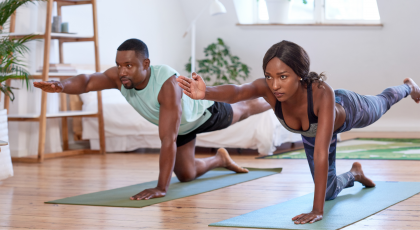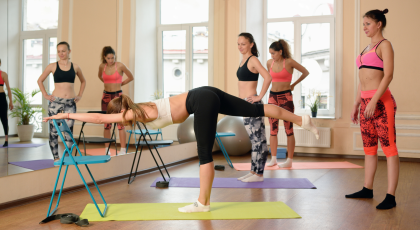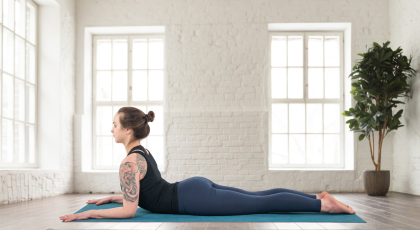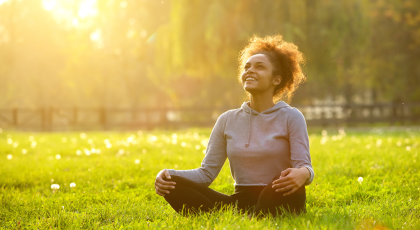View basket (0 items $0.00)

Is Yoga Helpful for Osteoporosis?
Osteoporosis is a health condition that weakens bones and makes them more brittle and, therefore, more susceptible to fracture. The word osteoporosis itself means “porous bone.” It is a common condition, particularly in postmenopausal women. There are a number of known modalities to help with osteoporosis, but they can be challenging, expensive, or injurious. So an interesting question is whether yoga for osteoporosis is effective.
Because yoga can be modified to be gentle and can accommodate various levels of practitioners, it seems like a worthwhile avenue to investigate for the prevention of and/or treatment of osteoporosis. To date, there has been limited research on this specific topic, but there have been some interesting studies worth investigating further on yoga and osteoporosis.
What Does the Research Say About Yoga for Osteoporosis?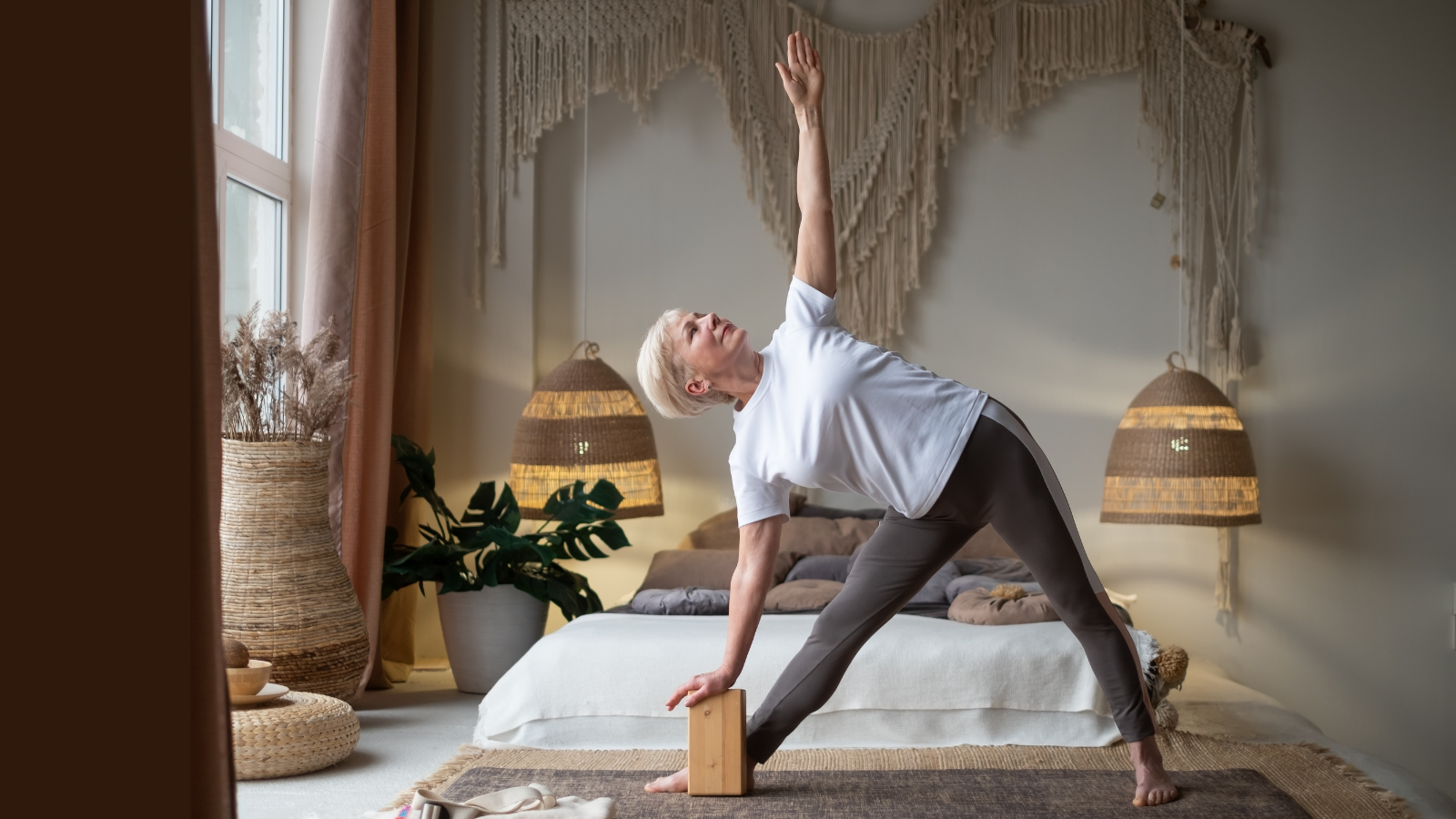
A pilot study from 2009 theorized that yoga could be an innocuous and inexpensive treatment for osteoporosis and worked with a small sample size to test this theory. Using dual-energy x-ray absorptiometry (DEXA) scans to check for bone density, researchers scanned participants two years before and after practicing yoga for 10 minutes per day.
What they found was that participants gained bone density within the spine and hips. Participants had no injuries as a result of their training regimen. This showcases yoga to be a potentially useful modality for building bone mineral density in postmenopausal women.
In 2010, another small study looked at the effects of yoga for osteoporosis in training balance and improving quality of life in postmenopausal women. This study, again, found promising results that showed that yoga education had a positive effect on pain, physical functions, and social functions in participants.
Another small study in 2016 looked at the effects of asana, pranayama, and Sun Salutation exercises to determine if yoga for osteoporosis could be an effective treatment modality. They, too, found that yoga showed a statistically significant improvement in bone mineral density in postmenopausal osteoporotic women.
Again in 2016, another larger and longer study found that just 12 minutes of daily yoga could help reverse the effects of osteoporotic bone loss.
In 2021, a more comprehensive systematic review and meta-analysis looked at the effectiveness of yoga and Pilates in improving bone density in adult women. The review pooled together 11 studies, including 591 participants aged between 45 and 78 years. They found non-significant results that suggested that mind-body exercises (like Pilates and yoga) did not produce a significant improvement in bone mineral density among adult women when compared to control groups.
However, the researchers mentioned that since bone mineral density typically decreases with age, a static or maintained bone mineral density “could be understood as a positive result added to the beneficial impact of Pilates-Yoga in multiple fracture risk factors, including but not limited to strength and balance.”
A Few Caveats to Consider When Thinking About Yoga for Osteoporosis
It’s important to note that most of the studies exploring the use of yoga for osteoporosis had extremely small sample sizes and a strong bias toward postmenopausal women. Therefore, it’s hard to apply their findings to the general population.
Furthermore, few of these studies were blinded or randomized, or even strictly controlled. So again, it’s hard to draw broad conclusions from them. It’s unknown if the bone mineral density improvements in participants came from the yogic interventions or from other daily activities that the participants took part in.
Also, since the majority of these study participants were volunteers, there is likely a self-selecting bias at play. These women were actively seeking out treatment modalities for their osteoporosis and likely viewed yoga as a safe movement modality. Therefore, they were more likely to be compliant and complete their exercises. With the general population, compliance may be lower. Therefore, it might produce less significant results, whereas other movement modalities might produce equally significant results even with low compliance.
It would be interesting to see studies that specifically utilized yoga against a control group that did a different movement modality (such as walking, weight lifting, or otherwise) to see if the results still held up as statistically significant.
What is worth noting, however, is that throughout the duration of all of these studies, not one serious yoga-related injury was reported. It’s encouraging that yoga will likely not lead to injury when used as an intervention with osteoporotic students.
The Takeaway on Yoga for Osteoporosis
Wolff’s Law states that bone in a healthy animal will adapt to the loads under which it is placed. Over time, as loading increases, the bone will remodel itself to become more resistant to those loads and, therefore, more resilient. This is why resistance exercise (like weight lifting) is a tried-and-true method of building bone density.
But practices like yoga may be helpful for osteoporosis patients in that they can add gradual resistance and load to improve bone density over time. However, once enough bone density is rebuilt, practitioners may reach a plateau in their training because body weight might not be enough of a load.
Yoga is a highly adaptable practice that practitioners can revert or progress to meet the needs of each individual. But it is typically practiced without applied external loads (such as weights). So it may be a helpful intervention for those with moderate to severe osteoporosis to help gradually rebuild bone mineral density. But it may not apply enough load for those in earlier osteopenic or osteoporotic stages.
This topic definitely warrants more research. Keep an eye on Dr. Loren Fishman, MD, a strong researcher in this specific field. His research and work around this topic is insightful, interesting, and very promising.
Until we have much more clear evidence about this topic, it’s likely safe to say that yoga—if practiced carefully, mindfully, and intentionally—will likely not lead to further harm in osteopenic and osteoporotic patients. It may offer a plethora of other benefits as well.
 Leah Sugerman is a yoga teacher, writer, and passionate world traveler. An eternally grateful student, she has trained in countless schools and traditions of the practice. She teaches a fusion of the styles she has studied, emphasizing breath, alignment, and anatomical integrity. Leah teaches workshops, retreats, and trainings, both internationally and online. For more information, visit www.leahsugerman.com.
Leah Sugerman is a yoga teacher, writer, and passionate world traveler. An eternally grateful student, she has trained in countless schools and traditions of the practice. She teaches a fusion of the styles she has studied, emphasizing breath, alignment, and anatomical integrity. Leah teaches workshops, retreats, and trainings, both internationally and online. For more information, visit www.leahsugerman.com.
Resources
1.) Fishman, Loren M. MD, BPhil(Oxon). Yoga for Osteoporosis: A Pilot Study. Topics in Geriatric Rehabilitation: July 2009 - Volume 25 - Issue 3 - p 244-250
doi: 10.1097/TGR.0b013e3181b02dd6
2.) Tüzün S, Aktas I, Akarirmak U, Sipahi S, Tüzün F. Yoga might be an alternative training for the quality of life and balance in postmenopausal osteoporosis. European Journal of Physical and Rehabilitation Medicine. 2010 Mar;46(1):69-72. PMID: 20332729.
3.) Motorwala, Z. S., Kolke, S., Panchal, P. Y., Bedekar, N. S., Sancheti, P. K., & Shyam, A. (2016). Effects of Yogasanas on osteoporosis in postmenopausal women. International Journal of Yoga, 9(1), 44-48. https://doi.org/10.4103/0973-6131.171717
4.) Lu, H., Rosner, B., Chang, G., & Fishman, L. M. (2016). Twelve-Minute Daily Yoga Regimen Reverses Osteoporotic Bone Loss. Topics in Geriatric Rehabilitation, 32(2), 81-87. https://doi.org/10.1097/TGR.0000000000000085
5.) Fernández-Rodríguez, R., Alvarez-Bueno, C., Reina-Gutiérrez, S., Torres-Costoso, A., de Arenas-Arroyo, S. N., & Martínez-Vizcaíno, V. (2021). Effectiveness of Pilates and Yoga to improve bone density in adult women: A systematic review and meta-analysis. PLOS ONE, 16(5), e0251391. https://doi.org/10.1371/journal.pone.0251391
Featured Courses
